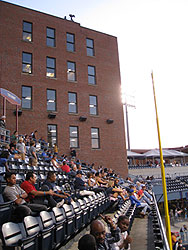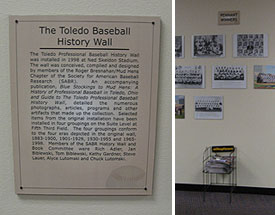|
At the time of this interview, Joe Napoli has been the General Manager of the Toledo Mud Hens for a dozen years, a tenure that easily covers the lifespan of his team's ballpark, Fifth Third Field, which opened in 2002, and harkens back to the days of Ned Skeldon Stadium, where the Hens played from 1965 to 2001. Joe answered these questions about his current and former workplace five days before summer officially began in 2010.
The Mud Hens played in suburban Maumee at Ned Skeldon Stadium until 2001. When and how did the push for a new ballpark begin?
A new ballpark of the Hens had been talked about for 5 years.
Was there ever any consideration given to staying in an upgraded version of the old stadium in Maumee?
Yes. Upgrading Ned Skeldon Stadium was going to cost about $18-$20 million and we would still have had a converted harness racing track without many of the modern amenities.
Baseball Pilgrimages note: Ned Skeldon Stadium had been a horse racing track for many decades before being bought and converted into a ballpark by Lucas County in 1965.
One of the highlights of Fifth Third Field is its location in downtown Toledo's Warehouse District, which is thriving now but was mostly forlorn prior to the Mud Hens' arrival. How did it come to be that the ballpark was built in the Warehouse District and were any other locations under consideration?
There were as many as eight (8) locations under consideration – the site was chosen because we thought it presented the best opportunity for redevelopment in downtown Toledo.
Most ballparks built since the late 1990s were designed by HOK Sport, the architectural firm now known as Populous but always renowned for designing sports facilities. Fifth Third Field was designed by HNTB. How were they picked?
Several firms competed – we interviewed firms including HOK and HNTB. HNTB did a wonderful job in the “spirit” of what we wanted to accomplish – an intimate, cozy ballpark nestled into the downtown Toledo Warehouse District loaded with unique characteristics that our community could be proud of.
Funding for construction of Fifth Third Field came from a number of sources - state, county, naming rights sponsor and the Mud Hens. What did the team contribute and how much say did the Mud Hens have in the design of the ballpark?
The Toledo Mud Hens are an Ohio not-for-profit corporation – our goal was to raise at least 14 million dollars. We have exceeded that goal through the sale of suites, naming rights to Fifth Third Bank and the net proceeds from annual operations.
 The adaptive reuse of a six-story, century old warehouse and the home run porch, named The Roost, attached to it are the signature features of Fifth Third Field. Was preserving the old warehouses in right field a part of the initial master plan and who should get credit for The Roost, which was named the best seating section in all of minor league baseball by ESPN.com in 2007?
The adaptive reuse of a six-story, century old warehouse and the home run porch, named The Roost, attached to it are the signature features of Fifth Third Field. Was preserving the old warehouses in right field a part of the initial master plan and who should get credit for The Roost, which was named the best seating section in all of minor league baseball by ESPN.com in 2007?
The preservation of the Washington Street [warehouse] was always part of the plan – we knew that we could be creative by adapting the building which was “The National Supply Company.” The warehouse includes The Roost Banquet Hall, Swamp Shop and team offices for the Toledo Mud Hens and Toledo Walleye.
The idea of The Roost came from a brainstorming session with the architectural team, Erik Ibsen and me. As soon as the idea was discussed, our gut instinct was that we had a neat idea.
The Mud Hens' ballpark was the second in the state of Ohio to carry the name Fifth Third Field, as Dayton's Fifth Third Field opened two years prior to Toledo's. Did the team or the people from Fifth Third Bank ever consider altering the name slightly, say to Fifth Third Park, to differentiate it or avoid confusion?
Yes, however, Fifth Third Bank thought and we agreed that the branding of multiple parks by the same name would be beneficial to the bank’s marketing plans.
Most ballparks built in the past decade have a berm in the outfield. In Toledo, outfield seating is limited to terraces filled with picnic tables that can be rented out by groups. What was the reasoning behind the exclusion of lawn seating at Fifth Third Field?
We decided to exclude the berm for one major reason – it’s not unusual for it to rain during the summertime. We had the good fortune to be at another ballpark with a berm during a rain delay – we were disappointed to see many of the folks with berm seats head for the exits even though the sun came back out after 20 minutes. The picnic tables have been very popular for group outings, and for families and friends.
Although there is plenty of parking near the ballpark - the Hens' Web site touts 6,623 spaces within a quarter mile - no official stadium parking lot exists. Was that something the team asked for and was denied due to the limited real estate surrounding the park, or did the city have a desire to spread the wealth among the downtown businesses and lots, who charge $4 to $8 to park?
The goal was to encourage fans to walk through downtown past bars and restaurants, retail, apartments and condos before and after the Hens’ games… surrounding Fifth Third Field with one giant parking lot would not have encouraged downtown redevelopment.

Out of sight but not off-limits, the Toledo Baseball History Wall is in the suite level at Fifth Third Field, where fans can literally take a stroll down memory lane.
|
Toledo has a long history with professional baseball, dating all the way back to 1883. The fabulous Toledo Baseball History Wall chronicles much of that history, but unfortunately the only people exposed to it are those that can walk the interior hall on the suite level, which is off-limits to fans not privileged enough to be using one of the ballpark's 32 suites. Will any portion of the artifact and photo-covered History Wall ever be moved or replicated on the main level concourse, or another place where more fans can see it?
Anyone may view the Toledo Baseball History Wall; we would never turn away a fan that has interest in seeing it.
Since 2006, the Mud Hens have held a High School Home Run Derby after a select number of summer games. How did that idea come about?
The Mud Hens had the unique privilege of hosting the [Triple-A] All-Star Game and All-Star Week in 2006. The High School Home Run Derby was born at a brainstorming session as to how we might include the amateur baseball community in the festivities and continues to this day.
Is it fair to say the success of Fifth Third Field and its impact on downtown Toledo has exceeded all expectations?
Yes. In 2000, KPMG /Peat Marwick predicted that Fifth Third Field would have an annual economic impact of roughly $19 million. If we applied the same formula they used (without inflation) the economic impact exceeds $50 million on an annual basis. Over 40 new businesses, apartments, townhouses, bars and restaurants have opened within a 4-block radius of Fifth Third Field.
EXTRA INNINGS
In addition to being President & General Manager of the Toledo Mud Hens Baseball Club, Joe Napoli serves in the same capacities for the Toledo Walleye Hockey Club. A graduate of St. John's University, he has previously worked for the Canton-Akron Indians, Chicago Bulls and Detroit Tigers. Joe's favorite major league ballpark is Pittsburgh's PNC Park, while he cites Victory Field in Indianapolis, Huntington Park in Columbus, OH, and Louisville Slugger Field among his favorites in the minors.
A special thank you goes out to Tracy Evans, the Executive Assistant for Joe Napoli, who helped facilitate this interview, which was conducted by e-mail. |
